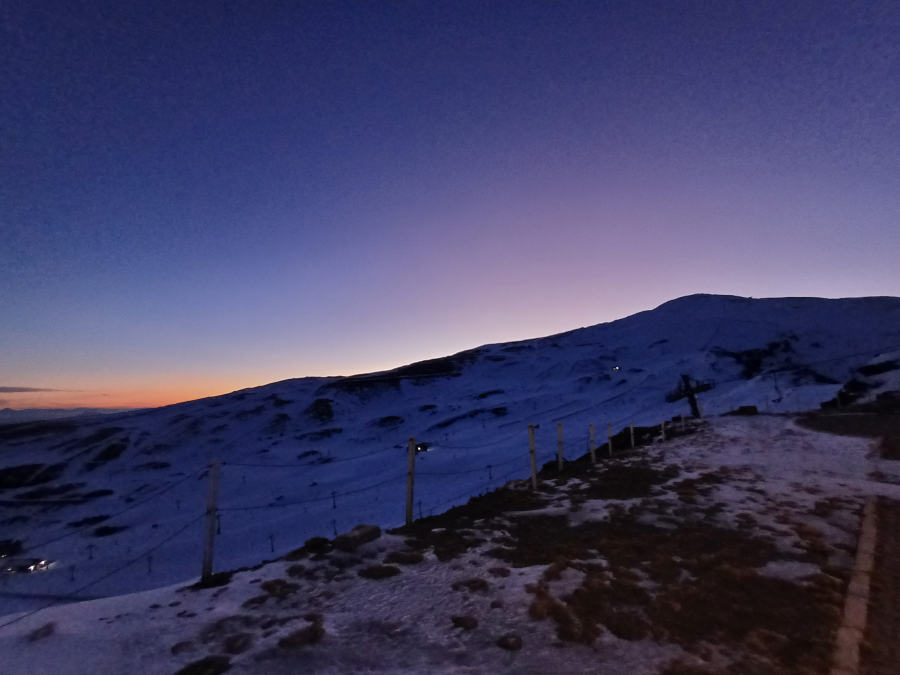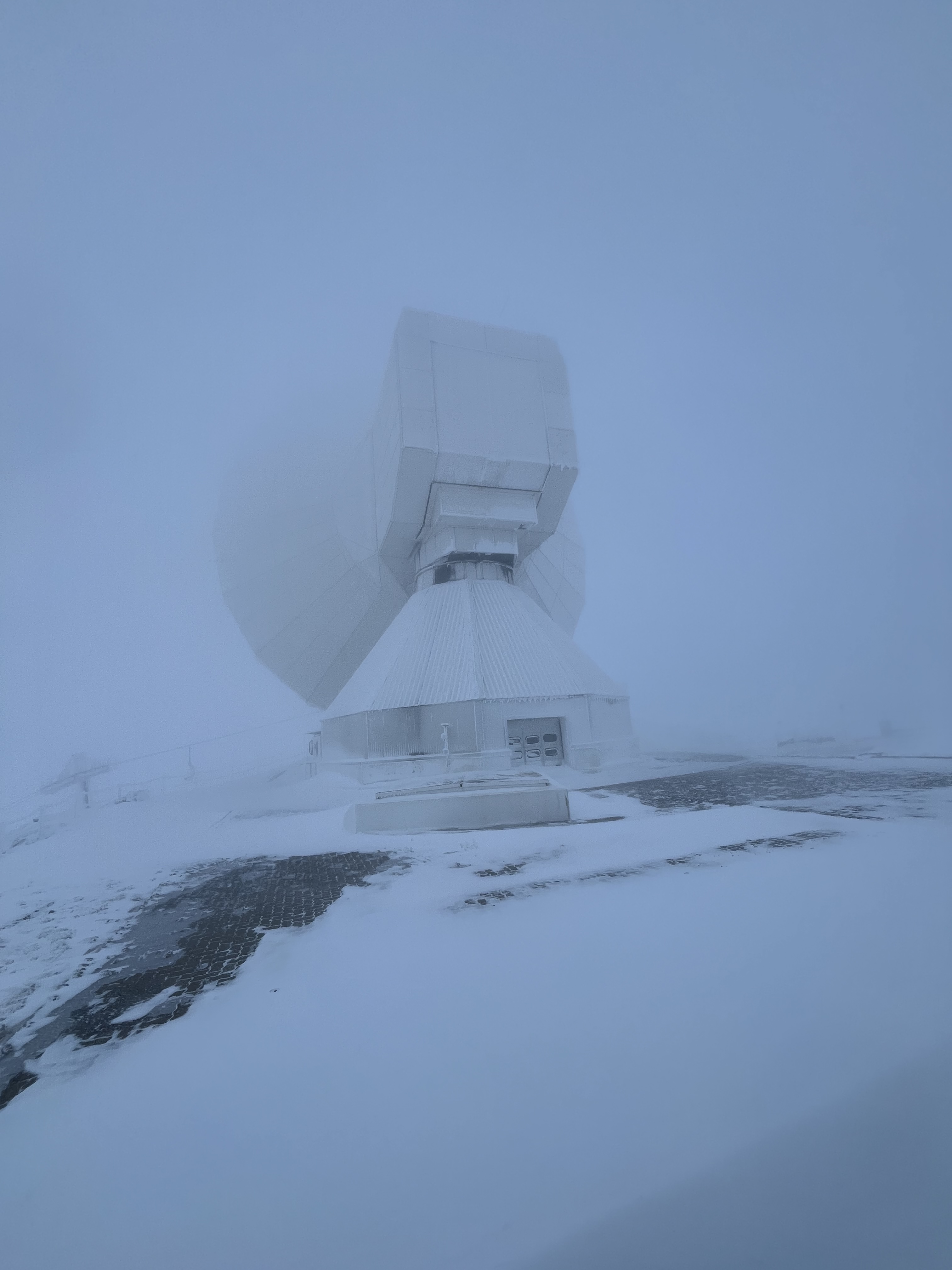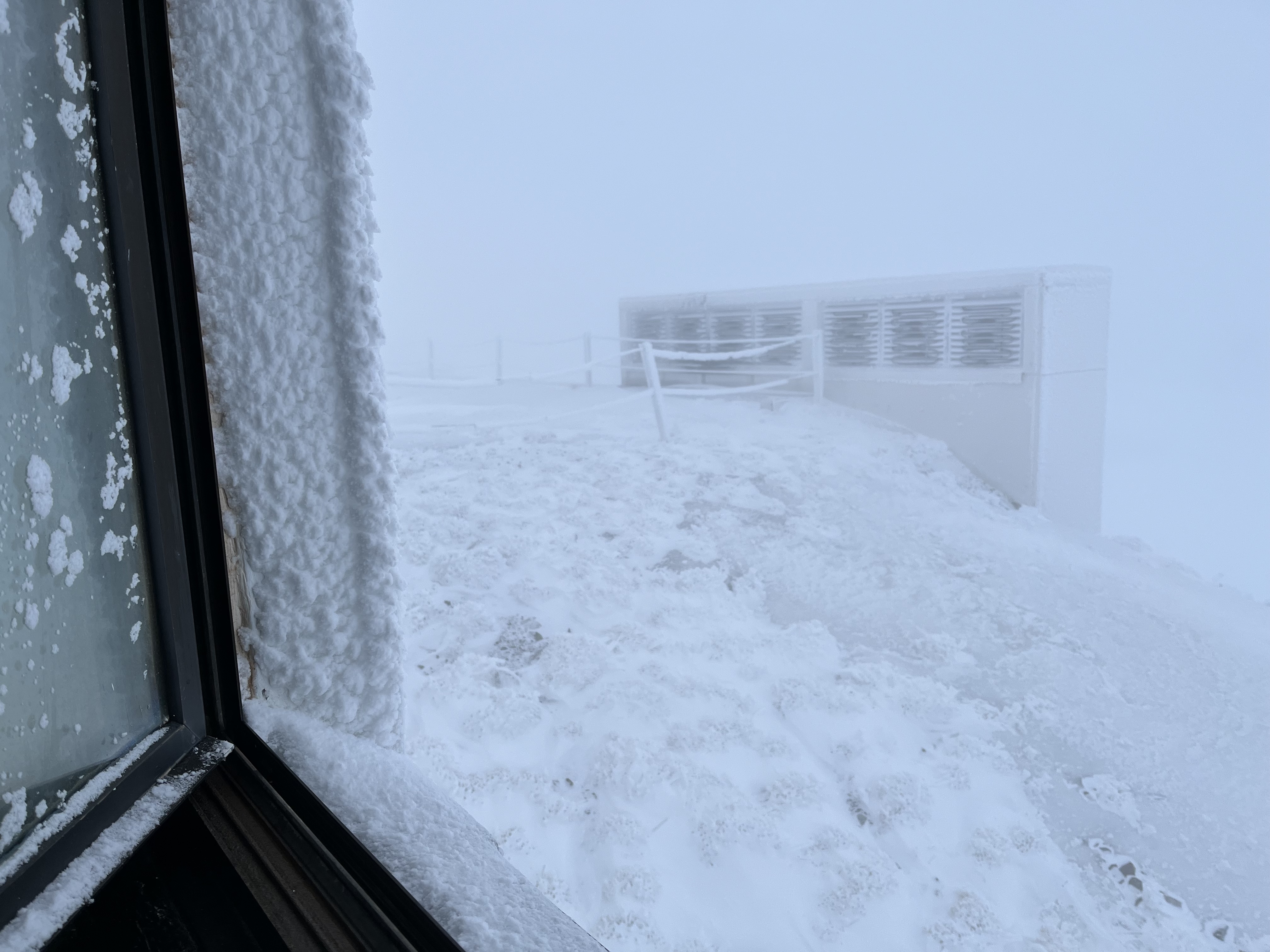Daily Reports
Contents
2024 Feb. 20th, Tuesday
Ioannis, Kaiyi, Hervé, Philippe, and Ste B. arrived at the telescope.
Maintenance: the telescope and NIKA2 are healthy. The HWP has been tested and rotates correctly. All is ready for a great week ![]()
16:00-20:00; Angel, Stefano, Ioannis, Hervé, Kaiyi: Tuning after maintenance was very good (bad kids 13/2/16). It was done at high elevation of ~70 deg. Then we did pointing and focus on the quasar 0316+413. The beam size for several pointings remained ~ 17.7 x 18.5" at 2mm. The small ellipticity seemed to remain also after focus corrections. Atmospheric stability was ~ 2-5 Jy/beam for the 2mm data. Around 17:00 we started a training session of NIKA2 observations for Hervé and Kaiyi. Then started observations of project 150-23 and did also a skydip [scan 20240220s82]. After initial pointing, we loaded an OTF map on source "id307" but we had to stop the observations after only one scan was completed (around 19:30) because the wind velocity exceeded the limit (reached up to ~ 14 m/s). Tracking deterioration was also visible up to the point that we stopped.
Note that scan 20240220s82 was not processed and a "synchronization problem" message appeared on the PIIC ql monitor screen. The file size kept increasing for a long duration and I had to stop the imbfits creation process. After consulting with Stefano, we realized that this might have been caused because the telescope was slewing for a long time to the source position when a "pointing" command was issued. A "track" command should have been used instead to avoid this large imbfits file creation.
Input by Hervé: The shift was mostly dedicated to the observation of source id307 of the project 150-23. We also performed a 6 minutes skydip [20240220s82]. The beam was checked two times in a nearby target (source 0716+714), yielding a quite stable beam of ~ 17.5*19 arcsec. Observations started with good conditions (stability characterised by RMS of about +/- 1-2 Jy). Unfortunately, the shift closed at about 19:00 due to wind ~14 m.s-1. In the end, only the first scan (1/4) of the first of two rounds that were scheduled in the observation script was performed.
20:00-02:00; Philippe and Ioannis: Wind drops below limit around 00:30 and we start with a tuning (bad kids 14/2/14). Sky stability very good with rms ~ 1-2 Jy/beam @ 2mm. Encountered problem with synchronization of data files. Restarted several systems (data collector, imbfits file creation, acquisition sw and retuning, ACU communication system etc.) but didn't help. Then we restarted taumeter system that was stopped for a while and files are now properly created and processed again.
Wind... imagine strange noises... sigh.
2024 Feb. 21st, Wednesday
02:00-08:00 (local time); Stefano: after pointing and focus performed in nikaw-23, I switch on the good old "Telescope Chillin'" playlist to help me wake up and I start observing for 153-23. Very low wind (~3 m/s avg), very low tau (<0.1 on the 225 taumeter), very stable sky (<+/-0.5 Jy along the timeline of a pointing (first two subscans), i.e. scanning in Az).
- 2 repetitions of AR2623 (El~49-52 deg) before culmination
- pointing/focus check, rather important sidelobes (~10%) that influence the Gaussian fit of the main beam (MB) to be up to FWHM~17x19 arcsec at 2mm (note that it's a fit mislead by the sidelobes, i.e. not really MB only; as the most prominent sidelobes (the Mickey Mouse ears) are for focused maps along the minor axis of the fit, the 1-component Gaussian fit is rounder than the main beam; also important: the 2mm NIKA2 beam does not say much about the quality of the 1mm beams).
- 2x0.15 repetition of AR2747 at high elevation (El~74-77 deg) before culmination. See comments on Tapas.
- 2 repetitions of AR2623 after culmination
- pointing/focus check
- 2 repetitions of AR2747 after culmination
- pointing/focus check
- 1 last repetition of AR2747
Note the large pointing offsets (~11 ~7 arcsec) close to Az~180 deg (i.e. South) and El~55 deg.
08:00-14:00; Kaiyi: The weather condition was good, with tau_225GHz~0.1. After adjusting the pointing and focus (stability with in +/- 0.5 Jy/beam), we did flux calibration with MWC349 (Scan No. 82), NGC7027 (Scan No.83) and CRL2688 (Scan No. 84), following with skydip (Scan No. 85). We observed the project 106-23 with its source: 20243+3853, but only finished 1 round of the scan. And we stopped and changed to other project because the elevation of the targets in this project were too high. We observed the project 015-17. Moving to Mars to try some polarimetry. The observation is done by the PI of this project. During the observation, the 2200+420 point source is selected for calibration (calib_1scan, Scan No.111, but took a very long time to write the imb.fits ~ 0.5 hr). Started the scan of DR21OH.
Philippe's input on B-FUN observations: Clear sky, low opacity (tau225 ~ 0.15), good to very good stability +/- 1-5 Jy/beam @ 2mm. Started with NIKA2-Pol around 11am (UT) [IM: Good tuning with HWP, bad kids 27/2/34]. Took 1 calib_1scan on Mars (s107), 2 calib_1scans on MWC349 (s113 and s118), 1 calib_1scan_high_el (@ 25"/sec; s111) + 1 calib_1scan (@ 40"/sec; s111) on BL Lac=2200+420, and observed 1sequence of 3 maps on DR21OH for the BFUN project (s114-116). While doing so, experienced big overheads due to the very long time needed by the system to create the imbfits files for, e.g. pointing/focus scans after long science maps and/or long slews.
14:00-20:00; Hervé: The shift started with a switch from polarimetry calibrations previously performed toward MWC349 and 2200+420 (project 015-17) to photometry observations with NIKA2. Unfortunately and despite a constantly low atmosphere opacity (tau < 0.2), NIKA2 observations turned out to be precluded by an irregular beam shape, likely affected by fast variations of the atmosphere temperature [IM: thermal instabilities of the dish]. Specifically, the beam looked asymmetric with a fwhm of 17.91*22.3 arcsec, even toward a bright source (0316+413) that we selected opposite to the Sun. The situation was similar or slightly worse toward Uranus, with a very irregular beam shape on both the NIKA2 bands. In the middle of the shift and during the sunset (17.00-19.00), we decided to wait for stabilization of the atmosphere temperature, and to switch from NIKA2 observations to a 2 hour run of EMIR observations of the source W3-IRS5 of the EMIR backup project 104-23.
No caption needed:
20:00-02:00; Philippe: back to NIKA2. Lost KIDs 28/2/34. A few light high-altitude clouds, opacity tau225 ~ 0.20-0.25, typical sky stability +/- 5 Jy/beam @ 2mm. Restarted with NIKA2 after EMIR backup observations around 20:30 UT. Waited until sky stabilized and took 1 calib_1scan on Uranus (s189), 1 calib_1scan on CRL618 (s192), and 1 calib_1scan on ALF-ORI (s194), along with a skydip (20240221s195). Then, observed 2 sequences of 2x4 maps on id307 for project 150-23 (s197-s204, s215-s218 on 20240221 and s1 to s4 on 20240222) with script ~/150-23/observe_id307.pako.
2024 Feb. 22nd, Thursday
02:00-08:00; Stefano: I take over and continue to observe the 150-23 project:
- pointing/focus check
last repetition of id307 (8.3/8 rep. in total -> completed). tau(225)~0.2 much better than predicted. Sky stability within +/- 5 Jy/beam, as measured in pointing subscans in Az only. Scan nr. 2 of 8 experienced an isolated wind episode with speed up to 12 m/s
- pointing/focus check
- 2 repetitions of id386 (now the total is 5/8), tau(225) between 0.2 and 0.3, no wind, pointing/focus check between the two repetitions
I close the night with a skydip (scan 20240222s42) and I start some calibrations on the fantastic trio MWC349, NGC7027 and CRL2688 for the morning shift to complete.
08:00-14:00; Kaiyi: The weather condition was not bad, with tau_225GHz~0.2. We adjust the pointing, focus (stability within +/- 4 Jy/beam), and did flux calibration with MWC349 (Scan No. 51), NGC7027 (Scan No.52) and CRL2688 (Scan No. 53). We observed the project 106-23 with its source: 20243+3853, for only finish 1.75 round of the scans (totally 2.75/3 finished). The target goes too high and the scan stopped, so we shifted to other project. We observed the project 151-23 with its source: PSZ2G083, and we finished two repetitions. We observed the project 106-23 with its source: 19571+3113.
14:00-20:00; Hervé: The sky looked rather clear above the telescope, with just few cirrus at high elevations. The opacity constantly stayed around 0.25 during this afternoon/sunset session. The shift was mostly dedicated to the project 106-23 (PI F. Fontani), and ended with project 151-23 (P.I.s H. Bourdin; J.F. Macias-Perez). We first attempted to observe 19489+3030 (proj. 106-23), but did not manage to get stable enough observing conditions. Specifically, after two pointing and focus checks toward K3050A, the beam size and noise rms could not be constrained below [18*20; 18*21 arcsec and [-10/+5 Jy; +/-15] Jy, respectively. A likely reason for this instability was the location of 19489+3030 toward the major wind direction and towards the setting sun. We decided instead to observe two other sources of proj. 106-23, WB59-572 and WB89-670, both of them being located toward the East, thus opposed to the major wind direction and to the Sun. In these cases the beam size and stability turned out to remain constrained at 18*20 arcsec and +/- 3Jy, respectively. In the end, WB59-572 has been observed as scheduled, while only two of the three repetitions of WB89-670 were performed due to the elevation of the source. After sunset and a pointing check toward 0735+178 (beam size 16.84*19.1 arctic; noise rms +/- 5Jy), we ended the shift with repetition 4/6 scheduled toward PSZ2G206 for project 151-23. [calibration scans done during Hervé's shift: 20240222s116 (calib_1scan on CRL618) and 20240222s119 (skydip)]
20:00-02:00; Philippe: [IM: Stopped due to wind since 21:00]
2024 Feb. 23rd, Friday
02:00-08:00; Stefano: telescope parked the whole night because of wind, fog, frozen rain, ice, etc. etc.
08:00-14:00; Kaiyi: telescope still parked because of ice and wind
14:00-20:00; Hervé: telescope still parked because of ice; later in the afternoon we find ourselves immersed in the clouds.
20:00-02:00; Philippe: snowing ...
2024 Feb. 24th, Saturday
02:00-08:00; Stefano: snowing ...
08:00-14:00; Kaiyi: snowing ...
14:00-20:00; Hervé: snowing ...
20:00-02:00; Philippe: still parked.
2024 Feb. 25th, Sunday
02:00-08:00; Stefano: in the night telescope parked because there's ice on the sub-reflector and cannot be cleaned at night (new rules, given recent issues with the platform).
08:00-14:00; Kaiyi: parked
11:00 UT Stefano and Ioannis: we make a short test with the rotating HWP, measuring the traces and their power spectrum on the DAQ monitor. The goal is to determine the exact rotation frequency - nu(HWP) - of the HWP. Generally speaking, it is assumed that the ration between the DAQ sampling frequency - nu(DAQ) - is 16. This implies nu(HWP)=2.98 Hz. Nevertheless, while building the PIIC-Pol code, it turned out that the exact (measured) value of nu(HWP) is hard to find and is not known with the necessary precision. The question is if mechanical wear or some other effects (electronics?) can change nu(HWP). Some simple back of the envelope arithmetics we did on Friday shows that a non integer nu(DAQ)/nu(HWP) ration (i.e. not equal exactly to 16), could cause a systematic offset in the observed polarization angle. And we know that NIKA2 has a ~5.6 deg systematic. Unfortunately the spectral monitor does not seem to have a good enough time resolution to give us the exact value of nu(HWP). In fact the position of the peak checked there "moves" to a different value at each new spectrum taken. More investigation on this is needed, measuring nu(HWP) on the NIKA2-Pol data at level of the data reduction.
At 12:00 UT we resume observing... for 15 minutes, then the wind wakes us up from this dream...
14:00-20:00; Hervé: Bad weather, antenna stopped.
20:00-02:00; Philippe: Bad weather, antenna stopped.
2024 Feb. 26th, Monday
02:00-08:00; Stefano: the wind blows and whistles through the windows all night long; snow and frozen rain add a pleasant and continuous "tic tic tac toc tic tac" to this concert.
08:00-14:00; Kaiyi: snow
14:00-20:00; Hervé: snow
20:00-02:00; Philippe: snow
2024 Feb. 27th, Tuesday
02:00-08:00; Stefano: Short taste of tonight's observations
08:00-10:30: Nothing to report ...






